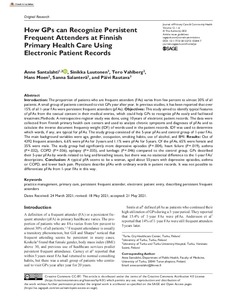How GPs can Recognize Persistent Frequent Attenders at Finnish Primary Health Care Using Electronic Patient Records
Luutonen Sinikka; Moen Hans; Rautava Päivi; Salanterä Sanna; Santalahti Anne; Vahlberg Tero
https://urn.fi/URN:NBN:fi-fe2021093047894
Tiivistelmä
Introduction: The proportion of patients who are frequent attenders (FAs) varies from few percent to almost 30% of all patients. A small group of patients continued to visit GPs year after year. In previous studies, it has been reported that over 15% of all 1-year FAs were persistent frequent attenders (pFAs).
Objectives: This study aimed to identify typical features of pFAs from the textual content in their medical entries, which could help GPs to recognize pFAs easily and facilitated treatment.
Methods: A retrospective register study was done, using 10 years of electronic patient records. The data were collected from Finnish primary health care centers and used to analyze chronic symptoms and diagnoses of pFAs and to calculate the inverse document frequency weight (IDF) of words used in the patient records. IDF was used to determine which words, if any, are typical for pFAs. The study group consisted of the 5-year pFAs and control group of 1-year FAs. The main background variables were age, gender, occupation, smoking habits, use of alcohol, and BMI.
Results: Out of 4392 frequent attenders, 6.6% were pFAs for 3 years and 1.1% were pFAs for 5 years. Of the pFAs, 65% were female and 35% were male. The study group had significantly more depressive episodes (P =.004), heart failure (P =.019), asthma (P =.032), COPD (P =.036), epilepsy (P =.035), and lumbago (P =.046) compared to the control group. GPs described their 5-year pFAs by words related to lung and breathing issues, but there was no statistical difference to the 1-year FAs’ descriptions.
Conclusion: A typical pFA seems to be a woman, aged about 55 years with depressive episodes, asthma or COPD, and lower back pain. Physicians describe pFAs with ordinary words in patient records. It was not possible to differentiate pFAs from 1-year FAs in this way. © The Author(s) 2021.
Author keywords
describing persistent frequent attenders; electronic patient entry; persistent frequent attender; practice management; primary care
Kokoelmat
- Rinnakkaistallenteet [19207]
